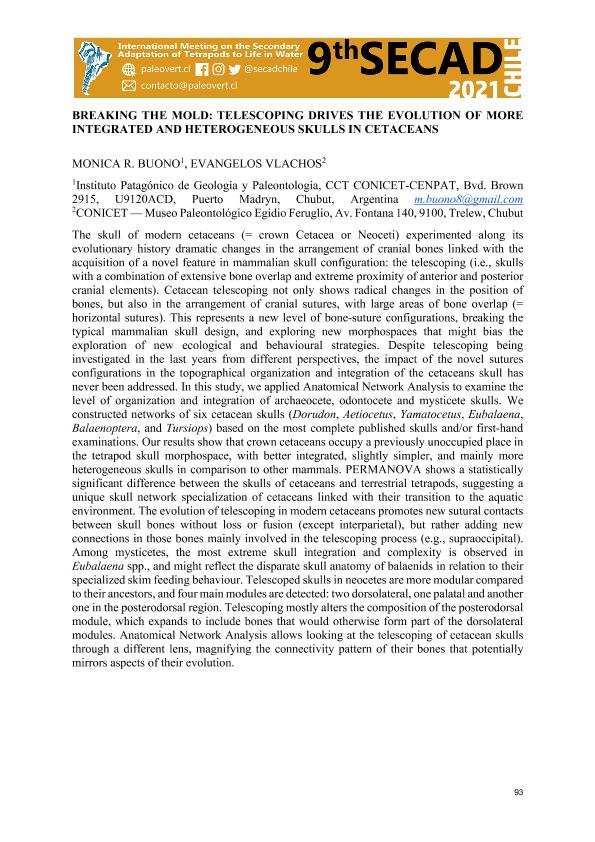Evento
Breaking the mold: Telescoping drives the evolution of more integrated and heterogeneous skulls in cetaceans
Tipo del evento:
Encuentro
Nombre del evento:
9th International Meeting on the Secondary Adaptation of Tetrapods to Life in Water
Fecha del evento:
19/04/2021
Institución Organizadora:
Asociación Paleontológica Argentina;
Asociación Chilena de Paleontología;
Título del Libro:
Abstract Book-9th International Meeting on the Secondary Adaptation of Tetrapods to Life in Water
Editorial:
Secondary Adaptation of Tetrapods to Life in Water
Idioma:
Inglés
Clasificación temática:
Resumen
The skull of modern cetaceans (= crown Cetacea or Neoceti) experimented along its evolutionary history dramatic changes in the arrangement of cranial bones linked with the acquisition of a novel feature in mammalian skull configuration: the telescoping (i.e., skulls with a combination of extensive bone overlap and extreme proximity of anterior and posterior cranial elements). Cetacean telescoping not only shows radical changes in the position of bones, but also in the arrangement of cranial sutures, with large areas of bone overlap (= horizontal sutures). This represents a new level of bone-suture configurations, breaking the typical mammalian skull design, and exploring new morphospaces that might bias the exploration of new ecological and behavioural strategies. Despite telescoping being investigated in the last years from different perspectives, the impact of the novel sutures configurations in the topographical organization and integration of the cetaceans skull has never been addressed. In this study, we applied Anatomical Network Analysis to examine the level of organization and integration of archaeocete, odontocete and mysticete skulls. We constructed networks of six cetacean skulls (Dorudon, Aetiocetus, Yamatocetus, Eubalaena, Balaenoptera, and Tursiops) based on the most complete published skulls and/or first-hand examinations. Our results show that crown cetaceans occupy a previously unoccupied place in the tetrapod skull morphospace, with better integrated, slightly simpler, and mainly more heterogeneous skulls in comparison to other mammals. PERMANOVA shows a statistically significant difference between the skulls of cetaceans and terrestrial tetrapods, suggesting a unique skull network specialization of cetaceans linked with their transition to the aquatic environment. The evolution of telescoping in modern cetaceans promotes new sutural contacts between skull bones without loss or fusion (except interparietal), but rather adding new connections in those bones mainly involved in the telescoping process (e.g., supraoccipital). Among mysticetes, the most extreme skull integration and complexity is observed in Eubalaena spp., and might reflect the disparate skull anatomy of balaenids in relation to their specialized skim feeding behaviour. Telescoped skulls in neocetes are more modular compared to their ancestors, and four main modules are detected: two dorsolateral, one palatal and another one in the posterodorsal region. Telescoping mostly alters the composition of the posterodorsal module, which expands to include bones that would otherwise form part of the dorsolateral modules. Anatomical Network Analysis allows looking at the telescoping of cetacean skulls through a different lens, magnifying the connectivity pattern of their bones that potentially mirrors aspects of their evolution.
Palabras clave:
CONNECTIVITY PATTERN
,
SUTURES
,
NEOCETI
,
ANATOMICAL NETWORKS
Archivos asociados
Licencia
Identificadores
Colecciones
Eventos(IPGP)
Eventos de INSTITUTO PATAGONICO DE GEOLOGIA Y PALEONTOLOGIA
Eventos de INSTITUTO PATAGONICO DE GEOLOGIA Y PALEONTOLOGIA
Citación
Breaking the mold: Telescoping drives the evolution of more integrated and heterogeneous skulls in cetaceans; 9th International Meeting on the Secondary Adaptation of Tetrapods to Life in Water; San Vicente de Tagua Tagua; Chile; 2021; 93-93
Compartir




